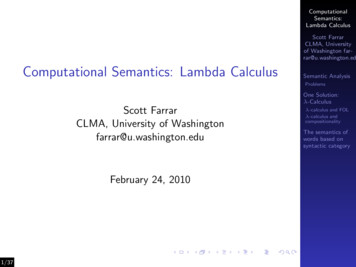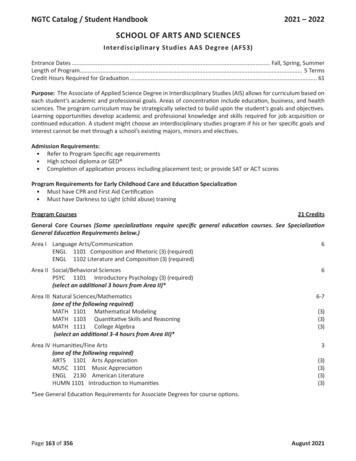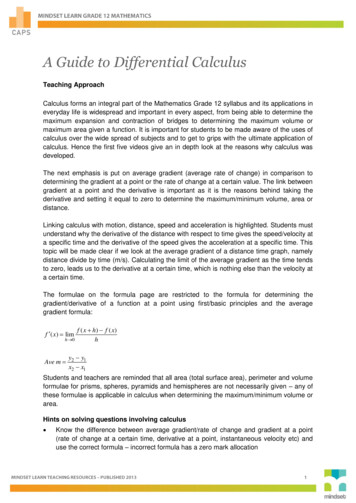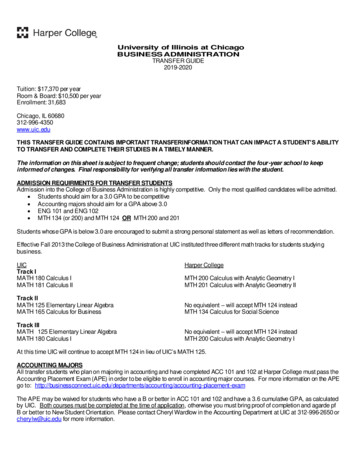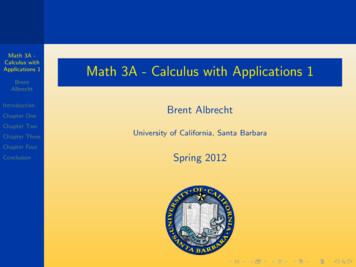
Transcription
Math 3A Calculus withApplications 1Math 3A - Calculus with Applications 1BrentAlbrechtIntroductionChapter OneBrent AlbrechtChapter TwoChapter ThreeUniversity of California, Santa BarbaraChapter FourConclusionSpring 2012
Course InstructorMath 3A Calculus withApplications 1BrentAlbrechtIntroductionChapter OneChapter TwoChapter ThreeChapter FourConclusionBrent AlbrechtOffice: SH 6431MOffice Hours: MWH 10:00 - 11:00 AM or By AppointmentE-mail: brentalbrecht@math.ucsb.edu
Course InformationMath 3A Calculus withApplications 1BrentAlbrechtIntroductionChapter OneChapter TwoChapter ThreeChapter FourConclusionCourse Description: Differential calculus including analyticgeometry, functions and limits, derivatives, techniques andapplications of differentiation, logarithmic and trigonometricfunctions.
Course InformationMath 3A Calculus withApplications 1BrentAlbrechtIntroductionChapter OneChapter TwoCourse Description: Differential calculus including analyticgeometry, functions and limits, derivatives, techniques andapplications of differentiation, logarithmic and trigonometricfunctions.Chapter ThreeChapter FourConclusionObjectives: To convey to the students the beauty and utility ofdifferential calculus, and to illustrate some of its applications inscience and engineering.
Course InformationMath 3A Calculus withApplications 1BrentAlbrechtIntroductionChapter OneChapter TwoCourse Description: Differential calculus including analyticgeometry, functions and limits, derivatives, techniques andapplications of differentiation, logarithmic and trigonometricfunctions.Chapter ThreeChapter FourConclusionObjectives: To convey to the students the beauty and utility ofdifferential calculus, and to illustrate some of its applications inscience and engineering.Text: Single Variable Calculus - Early Transcendentals, 7th Ed.by James Stewart or a Similar Text.
Course InformationMath 3A Calculus withApplications 1BrentAlbrechtIntroductionChapter OneChapter TwoChapter ThreeChapter FourConclusionDiscussion Sections: Each student must enroll in one of theassociated discussion sections. Attendance at discussionsections is mandatory.
Course InformationMath 3A Calculus withApplications 1BrentAlbrechtIntroductionChapter OneDiscussion Sections: Each student must enroll in one of theassociated discussion sections. Attendance at discussionsections is mandatory.Chapter TwoChapter ThreeChapter FourConclusionQuizzes: There will be a quiz during each discussion section.
Course InformationMath 3A Calculus withApplications 1BrentAlbrechtIntroductionChapter OneDiscussion Sections: Each student must enroll in one of theassociated discussion sections. Attendance at discussionsections is mandatory.Chapter TwoChapter ThreeChapter FourQuizzes: There will be a quiz during each discussion section.ConclusionHomework: Homework assignments are to be completed online.Homework assignments are due at 11:50 AM on Fridays (whenassigned on Mondays or on Fridays) and at 11:50 AM onWednesdays (when assigned on Wednesdays).
Course InformationMath 3A Calculus withApplications 1BrentAlbrechtIntroductionChapter OneChapter TwoChapter ThreeChapter FourConclusionCalculators: Students may use calculators when completinghomework assignments. Graphing calculators are prohibitedduring quizzes and exams.
Course InformationMath 3A Calculus withApplications 1BrentAlbrechtIntroductionChapter OneCalculators: Students may use calculators when completinghomework assignments. Graphing calculators are prohibitedduring quizzes and exams.Chapter TwoChapter ThreeChapter FourConclusionExams: There will be two midterm exams and onecomprehensive final exam.
Course InformationMath 3A Calculus withApplications 1BrentAlbrechtIntroductionChapter OneCalculators: Students may use calculators when completinghomework assignments. Graphing calculators are prohibitedduring quizzes and exams.Chapter TwoChapter ThreeChapter FourConclusionExams: There will be two midterm exams and onecomprehensive final exam.Midterm I: 12:00 - 12:50 PM on Wednesday, 25 April 2012
Course InformationMath 3A Calculus withApplications 1BrentAlbrechtIntroductionChapter OneCalculators: Students may use calculators when completinghomework assignments. Graphing calculators are prohibitedduring quizzes and exams.Chapter TwoChapter ThreeChapter FourConclusionExams: There will be two midterm exams and onecomprehensive final exam.Midterm I: 12:00 - 12:50 PM on Wednesday, 25 April 2012Midterm II: 12:00 - 12:50 PM on Monday, 14 May 2012
Course InformationMath 3A Calculus withApplications 1BrentAlbrechtIntroductionChapter OneCalculators: Students may use calculators when completinghomework assignments. Graphing calculators are prohibitedduring quizzes and exams.Chapter TwoChapter ThreeChapter FourConclusionExams: There will be two midterm exams and onecomprehensive final exam.Midterm I: 12:00 - 12:50 PM on Wednesday, 25 April 2012Midterm II: 12:00 - 12:50 PM on Monday, 14 May 2012Final: 12:00 - 3:00 PM on Tuesday, 12 June 2012
Course InformationMath 3A Calculus withApplications 1BrentAlbrechtIntroductionChapter OneChapter TwoChapter ThreeChapter FourConclusionGrading:
Course InformationMath 3A Calculus withApplications 1BrentAlbrechtIntroductionChapter OneChapter TwoChapter ThreeChapter FourConclusionGrading:Quizzes 10%
Course InformationMath 3A Calculus withApplications 1BrentAlbrechtGrading:IntroductionQuizzes 10%Chapter OneHomework 10%Chapter TwoChapter ThreeChapter FourConclusion
Course InformationMath 3A Calculus withApplications 1BrentAlbrechtGrading:IntroductionQuizzes 10%Chapter OneHomework 10%Chapter TwoChapter ThreeChapter FourConclusionMidterm I 20%
Course InformationMath 3A Calculus withApplications 1BrentAlbrechtGrading:IntroductionQuizzes 10%Chapter OneHomework 10%Chapter TwoChapter ThreeChapter FourConclusionMidterm I 20%Midterm II 20%
Course InformationMath 3A Calculus withApplications 1BrentAlbrechtGrading:IntroductionQuizzes 10%Chapter OneHomework 10%Chapter TwoChapter ThreeChapter FourConclusionMidterm I 20%Midterm II 20%Final 40%
Course InformationMath 3A Calculus withApplications 1BrentAlbrechtGrading:IntroductionQuizzes 10%Chapter OneHomework 10%Chapter TwoChapter ThreeChapter FourConclusionMidterm I 20%Midterm II 20%Final 40%Academic Integrity: Students are expected to uphold thehighest standards of academic integrity.
Course InformationMath 3A Calculus withApplications 1BrentAlbrechtIntroductionChapter OneChapter TwoChapter ThreeChapter FourConclusionAdditional Resources:
Course InformationMath 3A Calculus withApplications 1BrentAlbrechtIntroductionChapter OneChapter TwoChapter ThreeChapter FourConclusionAdditional Resources:The Math Lab in South Hall 1607
Course InformationMath 3A Calculus withApplications 1BrentAlbrechtIntroductionChapter OneChapter TwoChapter ThreeChapter FourConclusionAdditional Resources:The Math Lab in South Hall 1607Campus Learning Assistance Services (CLAS)
Course InformationMath 3A Calculus withApplications 1BrentAlbrechtIntroductionAdditional Resources:The Math Lab in South Hall 1607Campus Learning Assistance Services (CLAS)Chapter OneChapter TwoChapter ThreeChapter FourConclusionOther Important Dates:
Course InformationMath 3A Calculus withApplications 1BrentAlbrechtIntroductionAdditional Resources:The Math Lab in South Hall 1607Campus Learning Assistance Services (CLAS)Chapter OneChapter TwoChapter ThreeChapter FourConclusionOther Important Dates:Friday, 27 April 2012 is the last day to drop the class.
Course InformationMath 3A Calculus withApplications 1BrentAlbrechtIntroductionAdditional Resources:The Math Lab in South Hall 1607Campus Learning Assistance Services (CLAS)Chapter OneChapter TwoChapter ThreeChapter FourOther Important Dates:Friday, 27 April 2012 is the last day to drop the class.ConclusionMonday, 28 May 2012 (Memorial Day) is a universityholiday.
Course InformationMath 3A Calculus withApplications 1BrentAlbrechtIntroductionAdditional Resources:The Math Lab in South Hall 1607Campus Learning Assistance Services (CLAS)Chapter OneChapter TwoChapter ThreeChapter FourOther Important Dates:Friday, 27 April 2012 is the last day to drop the class.ConclusionMonday, 28 May 2012 (Memorial Day) is a universityholiday.Accommodations: Any student requiring accommodations orservices due to a disability must contact the Disabled StudentsProgram. I encourage any such students to contact me as well.
Mathematics and PhilosophyMath 3A Calculus withApplications 1BrentAlbrechtIntroductionChapter OneChapter TwoChapter ThreeChapter FourConclusionGalileo Galilei1564-1642
FunctionsMath 3A Calculus withApplications 1BrentAlbrechtIntroductionChapter OneChapter TwoChapter ThreeChapter FourConclusionThe fundamental objects that we deal with in calculus arefunctions.
FunctionsMath 3A Calculus withApplications 1BrentAlbrechtIntroductionChapter OneThe fundamental objects that we deal with in calculus arefunctions.Chapter TwoChapter ThreeChapter FourConclusionA function f is a rule that assigns to each element x in a set Dexactly one corresponding element, called f (x), in a set E . Theset D is called the domain of the function f . The range of thefunction f is the set of all possible values of f (x) as x variesthroughout the domain D.
Four Ways to Represent FunctionsMath 3A Calculus withApplications 1BrentAlbrechtIntroductionChapter OneChapter TwoChapter ThreeChapter FourConclusionFrom now on, we will assume that D and E are sets of realnumbers.
Four Ways to Represent FunctionsMath 3A Calculus withApplications 1From now on, we will assume that D and E are sets of realnumbers.BrentAlbrechtIntroductionChapter OneChapter TwoChapter ThreeChapter FourConclusionThere are (at least) four possible ways to represent a functionf : D E:
Four Ways to Represent FunctionsMath 3A Calculus withApplications 1From now on, we will assume that D and E are sets of realnumbers.BrentAlbrechtIntroductionChapter OneChapter TwoChapter ThreeChapter FourConclusionThere are (at least) four possible ways to represent a functionf : D E:Verbally
Four Ways to Represent FunctionsMath 3A Calculus withApplications 1From now on, we will assume that D and E are sets of realnumbers.BrentAlbrechtIntroductionChapter OneChapter TwoThere are (at least) four possible ways to represent a functionf : D E:VerballyChapter ThreeChapter FourConclusionNumerically
Four Ways to Represent FunctionsMath 3A Calculus withApplications 1From now on, we will assume that D and E are sets of realnumbers.BrentAlbrechtIntroductionChapter OneChapter TwoThere are (at least) four possible ways to represent a functionf : D E:VerballyChapter ThreeChapter FourConclusionNumericallyVisually
Four Ways to Represent FunctionsMath 3A Calculus withApplications 1From now on, we will assume that D and E are sets of realnumbers.BrentAlbrechtIntroductionChapter OneChapter TwoThere are (at least) four possible ways to represent a functionf : D E:VerballyChapter ThreeChapter FourConclusionNumericallyVisuallyAlgebraically
Four Ways to Represent FunctionsMath 3A Calculus withApplications 1From now on, we will assume that D and E are sets of realnumbers.BrentAlbrechtIntroductionChapter OneChapter TwoThere are (at least) four possible ways to represent a functionf : D E:VerballyChapter ThreeChapter osition (The Vertical Line Test)A curve in the xy -plane is the graph of a function f of x if andonly if no vertical line intersects the curve more than once.
Properties of FunctionsMath 3A Calculus withApplications 1BrentAlbrechtIntroductionA function f : D E is said to be injective ifx1 6 x2 f (x1 ) 6 f (x2 )Chapter OneChapter TwoChapter ThreeChapter FourConclusionfor all x1 , x2 D. (This means that no two distinct elements ofthe set D are sent by f to the same element of the set E , thatis, the function f never takes on the same value twice.)
Properties of FunctionsMath 3A Calculus withApplications 1BrentAlbrechtIntroductionA function f : D E is said to be injective ifx1 6 x2 f (x1 ) 6 f (x2 )Chapter OneChapter TwoChapter ThreeChapter FourConclusionfor all x1 , x2 D. (This means that no two distinct elements ofthe set D are sent by f to the same element of the set E , thatis, the function f never takes on the same value twice.)Proposition (The Horizontal Line Test)A function is injective if and only if no horizontal line intersectsits graph more than once.
Properties of FunctionsMath 3A Calculus withApplications 1BrentAlbrechtIntroductionChapter OneChapter TwoChapter ThreeChapter FourConclusionA function f : D E is said to be surjective if for everyelement y of E there exists an element x of D such that f (x) y . (This means that the set E is equal to the range of thefunction f , that is, the function f succeeds [at some point oranother of the set D] in taking on the value of each and everyelement of the set E .)
Properties of FunctionsMath 3A Calculus withApplications 1BrentAlbrechtIntroductionChapter OneChapter TwoChapter ThreeChapter FourConclusionA function f : D E is said to be surjective if for everyelement y of E there exists an element x of D such that f (x) y . (This means that the set E is equal to the range of thefunction f , that is, the function f succeeds [at some point oranother of the set D] in taking on the value of each and everyelement of the set E .)A function f : D E that is both injective and surjective issaid to be bijective.
Properties of FunctionsMath 3A Calculus withApplications 1BrentAlbrechtA function f : D E is said to be increasing (nondecreasing)on an interval I belonging to its domain D ifIntroductionChapter Onex1 x2 f (x1 ) f (x2 ) (f (x1 ) f (x2 ))Chapter TwoChapter ThreeChapter FourConclusionfor all x1 , x2 I .
Properties of FunctionsMath 3A Calculus withApplications 1BrentAlbrechtA function f : D E is said to be increasing (nondecreasing)on an interval I belonging to its domain D ifIntroductionChapter Onex1 x2 f (x1 ) f (x2 ) (f (x1 ) f (x2 ))Chapter TwoChapter ThreeChapter FourConclusionfor all x1 , x2 I .A function f : D E is said to be decreasing (nonincreasing)on an interval I belonging to its domain D ifx1 x2 f (x1 ) f (x2 ) (f (x1 ) f (x2 ))for all x1 , x2 I .
New Functions from Old FunctionsMath 3A Calculus withApplications 1BrentAlbrechtIntroductionChapter OneChapter TwoChapter ThreeChapter FourConclusionThere are many different ways to construct a new functionfrom a given function (or two):
New Functions from Old FunctionsMath 3A Calculus withApplications 1BrentAlbrechtThere are many different ways to construct a new functionfrom a given function (or two):IntroductionChapter OneChapter TwoChapter ThreeChapter FourConclusion(Translations) Let c 0. To obtain the graph of
New Functions from Old FunctionsMath 3A Calculus withApplications 1BrentAlbrechtThere are many different ways to construct a new functionfrom a given function (or two):IntroductionChapter One(Translations) Let c 0. To obtain the graph ofChapter TwoChapter ThreeChapter FourConclusiony f (x) c, shift the graph of y f (x) a distance of cunits upward.
New Functions from Old FunctionsMath 3A Calculus withApplications 1BrentAlbrechtThere are many different ways to construct a new functionfrom a given function (or two):IntroductionChapter One(Translations) Let c 0. To obtain the graph ofChapter TwoChapter ThreeChapter FourConclusiony f (x) c, shift the graph of y f (x) a distance of cunits upward.y f (x) c, shift the graph of y f (x) a distance of cunits downward.
New Functions from Old FunctionsMath 3A Calculus withApplications 1BrentAlbrechtThere are many different ways to construct a new functionfrom a given function (or two):IntroductionChapter One(Translations) Let c 0. To obtain the graph ofChapter TwoChapter ThreeChapter FourConclusiony f (x) c, shift the graph of y f (x) a distance of cunits upward.y f (x) c, shift the graph of y f (x) a distance of cunits downward.y f (x c), shift the graph of y f (x) a distance of cunits to the left.
New Functions from Old FunctionsMath 3A Calculus withApplications 1BrentAlbrechtThere are many different ways to construct a new functionfrom a given function (or two):IntroductionChapter One(Translations) Let c 0. To obtain the graph ofChapter TwoChapter ThreeChapter FourConclusiony f (x) c, shiftunits upward.y f (x) c, shiftunits downward.y f (x c), shiftunits to the left.y f (x c), shiftunits to the right.the graph of y f (x) a distance of cthe graph of y f (x) a distance of cthe graph of y f (x) a distance of cthe graph of y f (x) a distance of c
New Functions from Old FunctionsMath 3A Calculus withApplications 1BrentAlbrechtIntroductionChapter OneChapter TwoChapter ThreeChapter FourConclusion(Stretchings) Let c 1. To obtain the graph of
New Functions from Old FunctionsMath 3A Calculus withApplications 1BrentAlbrechtIntroductionChapter OneChapter TwoChapter ThreeChapter FourConclusion(Stretchings) Let c 1. To obtain the graph ofy cf (x), stretch the graph of y f (x) vertically by afactor of c.
New Functions from Old FunctionsMath 3A Calculus withApplications 1BrentAlbrechtIntroductionChapter OneChapter TwoChapter ThreeChapter FourConclusion(Stretchings) Let c 1. To obtain the graph ofy cf (x), stretch the graph of y f (x) vertically by afactor of c.y c1 f (x), shrink the graph of y f (x) vertically by afactor of c.
New Functions from Old FunctionsMath 3A Calculus withApplications 1BrentAlbrechtIntroductionChapter OneChapter TwoChapter ThreeChapter FourConclusion(Stretchings) Let c 1. To obtain the graph ofy cf (x), stretch the graph of y f (x) vertically by afactor of c.y c1 f (x), shrink the graph of y f (x) vertically by afactor of c.y f (cx), shrink the graph of y f (x) horizontally by afactor of c.
New Functions from Old FunctionsMath 3A Calculus withApplications 1BrentAlbrechtIntroductionChapter OneChapter TwoChapter ThreeChapter FourConclusion(Stretchings) Let c 1. To obtain the graph ofy cf (x), stretch the graph of y f (x) vertically by afactor of c.y c1 f (x), shrink the graph of y f (x) vertically by afactor of c.y f (cx), shrink the graph of y f (x) horizontally by afactor of c.y f xc , stretch the graph of y f (x) horizontally by afactor of c.
New Functions from Old FunctionsMath 3A Calculus withApplications 1BrentAlbrechtIntroductionChapter OneChapter TwoChapter ThreeChapter FourConclusion(Stretchings) Let c 1. To obtain the graph ofy cf (x), stretch the graph of y f (x) vertically by afactor of c.y c1 f (x), shrink the graph of y f (x) vertically by afactor of c.y f (cx), shrink the graph of y f (x) horizontally by afactor of c.y f xc , stretch the graph of y f (x) horizontally by afactor of c.(Reflections) To obtain the graph of
New Functions from Old FunctionsMath 3A Calculus withApplications 1BrentAlbrechtIntroductionChapter OneChapter TwoChapter ThreeChapter FourConclusion(Stretchings) Let c 1. To obtain the graph ofy cf (x), stretch the graph of y f (x) vertically by afactor of c.y c1 f (x), shrink the graph of y f (x) vertically by afactor of c.y f (cx), shrink the graph of y f (x) horizontally by afactor of c.y f xc , stretch the graph of y f (x) horizontally by afactor of c.(Reflections) To obtain the graph ofy f (x), reflect the graph of y f (x) about the x-axis.
New Functions from Old FunctionsMath 3A Calculus withApplications 1BrentAlbrechtIntroductionChapter OneChapter TwoChapter ThreeChapter FourConclusion(Stretchings) Let c 1. To obtain the graph ofy cf (x), stretch the graph of y f (x) vertically by afactor of c.y c1 f (x), shrink the graph of y f (x) vertically by afactor of c.y f (cx), shrink the graph of y f (x) horizontally by afactor of c.y f xc , stretch the graph of y f (x) horizontally by afactor of c.(Reflections) To obtain the graph ofy f (x), reflect the graph of y f (x) about the x-axis.y f ( x), reflect the graph of y f (x) about the y -axis.
New Functions from Old FunctionsMath 3A Calculus withApplications 1BrentAlbrechtIntroductionChapter OneChapter TwoChapter ThreeChapter FourConclusion(Algebraic Manipulations) Given two functions f and g ,we define
New Functions from Old FunctionsMath 3A Calculus withApplications 1BrentAlbrecht(Algebraic Manipulations) Given two functions f and g ,we defineIntroductionChapter OneChapter TwoChapter ThreeChapter FourConclusionthe function (f g ) by (f g )(x) f (x) g (x)
New Functions from Old FunctionsMath 3A Calculus withApplications 1BrentAlbrecht(Algebraic Manipulations) Given two functions f and g ,we defineIntroductionChapter OneChapter TwoChapter ThreeChapter FourConclusionthe function (f g ) by (f g )(x) f (x) g (x)the function (f g ) by (f g )(x) f (x) g (x)
New Functions from Old FunctionsMath 3A Calculus withApplications 1BrentAlbrecht(Algebraic Manipulations) Given two functions f and g ,we defineIntroductionChapter OneChapter TwoChapter ThreeChapter FourConclusionthe function (f g ) by (f g )(x) f (x) g (x)the function (f g ) by (f g )(x) f (x) g (x)the function (fg ) by (fg )(x) f (x)g (x)
New Functions from Old FunctionsMath 3A Calculus withApplications 1BrentAlbrecht(Algebraic Manipulations) Given two functions f and g ,we defineIntroductionChapter OneChapter TwoChapter ThreeChapter FourConclusionthe function (f g ) by (f g )(x) f (x) g (x)the function (f g ) by (f g )(x) f (x) g (x)the function (fg ) by (fg )(x) f (x)g (x)fthe function g (x) by gf (x) gf (x)(x)with the appropriate domain restrictions.
New Functions from Old FunctionsMath 3A Calculus withApplications 1BrentAlbrecht(Algebraic Manipulations) Given two functions f and g ,we defineIntroductionChapter OneChapter TwoChapter ThreeChapter FourConclusionthe function (f g ) by (f g )(x) f (x) g (x)the function (f g ) by (f g )(x) f (x) g (x)the function (fg ) by (fg )(x) f (x)g (x)fthe function g (x) by gf (x) gf (x)(x)with the appropriate domain restrictions.(Compositions) Given two functions f and g , we definethe composite function (f g ) by (f g )(x) f (g (x))with the appropriate domain restrictions.
Exponential FunctionsMath 3A Calculus withApplications 1BrentAlbrechtIntroductionChapter OneChapter TwoChapter ThreeChapter FourConclusionAn exponential function is a function of the formf (x) axwhere the value of the base a is a positive constant.
Exponential FunctionsMath 3A Calculus withApplications 1BrentAlbrechtIntroductionChapter OneChapter TwoChapter ThreeChapter FourConclusionAn exponential function is a function of the formf (x) axwhere the value of the base a is a positive constant.Consider the exponential function f (x) 2x . We know that
Exponential FunctionsMath 3A Calculus withApplications 1BrentAlbrechtIntroductionChapter OneChapter TwoAn exponential function is a function of the formf (x) axwhere the value of the base a is a positive constant.Consider the exponential function f (x) 2x . We know thatChapter ThreeChapter FourConclusionf (3) 23 2 · 2 · 2 8.
Exponential FunctionsMath 3A Calculus withApplications 1BrentAlbrechtIntroductionChapter OneChapter TwoAn exponential function is a function of the formf (x) axwhere the value of the base a is a positive constant.Consider the exponential function f (x) 2x . We know thatChapter ThreeChapter FourConclusionf (3) 23 2 · 2 · 2 8.f (0) 20 1.
Exponential FunctionsMath 3A Calculus withApplications 1BrentAlbrechtIntroductionChapter OneChapter TwoAn exponential function is a function of the formf (x) axwhere the value of the base a is a positive constant.Consider the exponential function f (x) 2x . We know thatChapter ThreeChapter FourConclusionf (3) 23 2 · 2 · 2 8.f (0) 20 1.f ( 2) 2 2 212 14 .
Exponential FunctionsMath 3A Calculus withApplications 1BrentAlbrechtIntroductionChapter OneChapter TwoAn exponential function is a function of the formf (x) axwhere the value of the base a is a positive constant.Consider the exponential function f (x) 2x . We know thatChapter ThreeChapter FourConclusionf (3) 23 2 · 2 · 2 8.f (0) 20 1.f ( 2) 2 2 212 14 . 1f 12 2 2 is one of the solutions to x 2 2.
Exponential FunctionsMath 3A Calculus withApplications 1BrentAlbrechtIntroductionChapter OneChapter TwoAn exponential function is a function of the formf (x) axwhere the value of the base a is a positive constant.Consider the exponential function f (x) 2x . We know thatChapter ThreeChapter FourConclusionf (3) 23 2 · 2 · 2 8.f (0) 20 1.f ( 2) 2 2 212 14 . 1f 12 2 2 is one of the solutions to x 2 2. 3f 32 2 2 is one of the solutions to x 2 23 or x 2 8.
Exponential FunctionsMath 3A Calculus withApplications 1BrentAlbrechtIntroductionChapter OneChapter TwoAn exponential function is a function of the formf (x) axwhere the value of the base a is a positive constant.Consider the exponential function f (x) 2x . We know thatChapter ThreeChapter FourConclusionf (3) 23 2 · 2 · 2 8.f (0) 20 1.f ( 2) 2 2 212 14 . 1f 12 2 2 is one of the solutions to x 2 2. 3f 32 2 2 is one of the solutions to x 2 23 or x 2 8.But what is the value of f when it is applied to an irrationalnumber like π?
Exponential FunctionsMath 3A Calculus withApplications 1BrentAlbrechtIntroductionChapter OneChapter TwoChapter ThreeChapter FourConclusionWe want to define such values of the function f in such a wayso as to keep f an increasing function on all of R. In particular,given values x and y such that x π y , we must requirethat 2x 2π 2y .
Exponential FunctionsMath 3A Calculus withApplications 1BrentAlbrechtIntroductionChapter OneChapter TwoChapter ThreeWe want to define such values of the function f in such a wayso as to keep f an increasing function on all of R. In particular,given values x and y such that x π y , we must requirethat 2x 2π 2y .Chapter FourConclusionIt turns out that there is exactly one number that is greaterthan all of the numbers 23 , 23.1 , 23.14 , . . . and less than all ofthe numbers 24 , 23.2 , 23.15 , . . . We define 2π to be thisnumber. It is equal to 8.8249778 . . .
Laws of ExponentsMath 3A Calculus withApplications 1BrentAlbrechtProposition (Laws of Exponents)IntroductionChapter OneChapter TwoIf a and b are positive numbers and x and y are any realnumbers, thenChapter ThreeChapter FourConclusionax y ax ay , ax y ax, (ax )y axy ,ayand (ab)x ax b x .
The Number eMath 3A Calculus withApplications 1BrentAlbrechtIntroductionChapter OneChapter TwoChapter ThreeChapter FourConclusionOf all of the possible bases for an exponential function, there isone that turns out to be the most convenient for the purposesof calculus. Indeed, some of the formulas of calculus will begreatly simplified if we can choose the base a in such a waythat the slope of the tangent line to the graph of theexponential function f (x) ax at the point (0, 1) is exactly 1.
The Number eMath 3A Calculus withApplications 1BrentAlbrechtIntroductionChapter OneChapter TwoChapter ThreeChapter FourConclusionOf all of the possible bases for an exponential function, there isone that turns out to be the most convenient for the purposesof calculus. Indeed, some of the formulas of calculus will begreatly simplified if we can choose the base a in such a waythat the slope of the tangent line to the graph of theexponential function f (x) ax at the point (0, 1) is exactly 1.There is a base value with this property, and we denote it bythe letter e. It is equal to 2.7182818284 . . ., and we refer tothe exponential function f (x) e x as the natural exponentialfunction.
Inverse FunctionsMath 3A Calculus withApplications 1BrentAlbrechtIntroductionChapter OneChapter TwoChapter ThreeChapter FourConclusionSuppose that we are interested in studying the growth rate of acertain type of bacteria. Working very carefully, we couldintroduce a single such bacterium into a closed andnutrient-rich environment. Having done this, we would findthat the number of bacteria N in the closed environment is afunction of the amount of time t that has elapsed since thebeginning, that is, N f (t).
Inverse FunctionsMath 3A Calculus withApplications 1BrentAlbrechtIntroductionChapter OneChapter TwoChapter ThreeChapter FourConclusionSuppose that we are interested in studying the growth rate of acertain type of bacteria. Working very carefully, we couldintroduce a single such bacterium into a closed andnutrient-rich environment. Having done this, we would findthat the number of bacteria N in the closed environment is afunction of the amount of time t that has elapsed since thebeginning, that is, N f (t).We would know how many bacteria there are at any given timet0 . (We could just feed the given time t0 into the function f toget the answer.) But what if we turned this question around?What if we asked instead how long it would take for thepopulation level to rise to some prescribed value N0 of N?
Inverse FunctionsMath 3A Calculus withApplications 1BrentAlbrechtIntroductionChapter OneChapter TwoChapter ThreeChapter FourConclusionWe would then need to understand the time t that has elapsedsince the beginning as a function of the number of bacteria N.This function is the one that we would call the inverse functionof f and denote by f 1 . Supposing the existence of thisfunction, we would write that t f 1 (N) and find the value off 1 (N0 ) to answer our question.
Inverse FunctionsMath 3A Calculus withApplications 1BrentAlbr
applications of di erentiation, logarithmic and trigonometric functions. Objectives: To convey to the students the beauty and utility of di erential calculus, and to illustrate some of its applications in science and engineering. Text: Single Variable Calculus - Early Transcendentals, 7th Ed. by James Stewart or a Similar Text.

